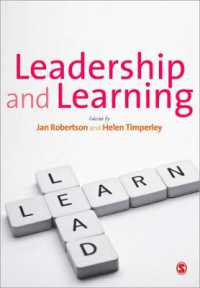- ホーム
- > 洋書
- > 英文書
- > Computer / General
Full Description
Maximize the Value of Your Information Throughout Even the Most Complex IT ProjectForeword by Tim Vincent, IBM Fellow and Vice President, CTO for IBM Analytics GroupTo drive maximum value from complex IT projects, IT professionals need a deep understanding of the information their projects will use. Too often, however, IT treats information as an afterthought: the "poor stepchild" behind applications and infrastructure. That needs to change. This book will help you change it.Five senior IBM architects show you how to use information-centric views to give data a central role in project design and delivery. Using Common Information Models (CIM), you learn how to standardize the way you represent information, making it easier to design, deploy, and evolve even the most complex systems.Using a complete case study, the authors explain what CIMs are, how to build them, and how to maintain them. You learn how to clarify the structure, meaning, and intent of any information you may exchange, and then use your CIM to improve integration, collaboration, and agility.In today's mobile, cloud, and analytics environments, your information is more valuable than ever. To build systems that make the most of it, start right here.Coverage Includes* Mastering best practices for building and maintaining a CIM* Understanding CIM components and artifacts: scope, perspectives, and depth of detail* Choosing the right patterns for structuring your CIM* Integrating a CIM into broader governance* Using tools to manage your CIM more effectively* Recognizing the importance of non-functional characteristics, such as availability, performance, and security, in system design* Growing CIM value by expanding their scope and usage * Previewing the future of CIMs
Contents
Foreword by Tim Vincent xixPreface xxChapter 1 Introduction 1The Agile and Open World 1GKDMR Travel 3Adding Mobile Applications to the Enterprise 4Social Computing 8Insight Applications 9Using Cloud Platforms 10Security of Data 12Summary 13Chapter 2 Inside the Common Information Model 15Introduction 15Scope 16Perspectives 17Information Supply Chains 19Model Types 20Depth of Detail 22A Comprehensive Common Information Model 23Developing a Strategy 26Summary 29Chapter 3 Structural Patterns for the Common Information Model 31Introduction 31Common Information Model 33Context 33Problem 33Example 34Forces 34Solution 35Consequences 36Example Resolved 37Known Uses 38Related Patterns 38Concept Beads 39Context 39Problem 39Example 39Forces 40Solution 40Consequences 42Example Resolved 43Known Uses 45Related Patterns 45Continuous Fabric 45Context 45Problem 45Example 46Forces 46Solution 46Consequences 47Example Resolved 48Known Uses 48Related Patterns 50Encapsulated Views 50Context 50Problem 50Example 51Forces 51Solution 51Consequences 52Example Resolved 54Known Uses 54Related Patterns 54Unifying Context 54Context 54Problem 55Example 55Forces 55Solution 55Consequences 56Example Resolved 57Known Uses 58Related Patterns 58Combining the Patterns 58Summary 59Chapter 4 Modeling Best Practices 61What Should Be in a Model? 61Deciding on the Scope of a Model 62Adopting Existing Models 63Basic Modeling Skills 64Leveling the Content 64Standardizing Basic Types 65Dealing with Variation 66Dependent and Independent Behaviors 68When to Use Inheritance 68The Role Pattern 69Designing for Consistency 70Designing for Reuse 71Designing for Extensibility 71Linking Subject Areas 73Tips for Modeling Interfaces 73Specialized Definitions of the Same Concept 73Context of a Request 75Versioning of Interfaces 75Tips on Modeling for a Repository 75Removing Duplication-How Far Do You Go? 76Storing Historical Information 77Effectivity Dating 77Modeling Unstructured Data 78Physical Implementation Details 78Summary 78Chapter 5 Governance 81Introduction 81Governance Definitions 83Governance Principles 84Governance Policies 84Governance Classification Schemes 85Governance Standards 86Governance Rules, Guidelines, and Patterns 87Governance Process Definitions 87Governance Metrics 87Managing Change 87Lifecycles of Governance 88Governance Leadership 90Governance Processes 92Governance Roles 93Everyday Decision Making 94Measurement and Audit 96Summary 96Chapter 6 Moving Beyond the Hammer 99Structuring and Maintaining Models 99Configuration Management 100Top-Down Configuration Management 102Bottom-Up Configuration Management 102Combining Approaches 103Consuming Models and Related Artifacts 104Managing Information Values 110Quality Management 111Reference Data Management 112Summary 112Chapter 7 System Characteristics 113Introduction 113Non-Functional Characteristics 114Reviewing GKDMR Travel 116Systems of Record 118SoR Non-Functional Characteristics 119CIM Implications for Systems of Record 120Systems of Engagement 122SoE Non-Functional Characteristics 123CIM Implications for Systems of Engagement 124Systems of Insight 126SoI Non-Functional Characteristics 129CIM Implications for Systems of Insight 131Integration 132Integration Requirements 134CIM Implications for Integration 135Summary 136Chapter 8 Building Business Value 137Complex Organizations 137Points of View at GKDMR Travel 138Adoption Maturity Model 140Repeatable Adoption Level 141Defined Adoption Level 141Managed Adoption Level 143Investing in the Common Information Model 145Optimizing Adoption Level 146APIs from Business Partners 149Unstructured Data Feeds 150Summary 151Chapter 9 Real-World Deployment Study 153The Background and the Industry 153Project Hydra 154The Common Information Model 157Refining the TMF-SID into Services 158Carving Up the TMF-SID 160Validating Consistency 162Extending the TMF-SID objects 162Pruning the Service Structures 163Implementing the Integration Layer 163Tools and Governance 164Results 165Chapter 10 Looking Forward 167Where We Have Come From 167Common Information Models Today 168Thoughts for the Future 169Concluding Remarks from the Authors 170Appendix A Industry Standards 171Telecommunications Models 171Finance Models 172Utilities Industry 172Appendix B Non-Functional Behavior 173Reliability and Availability 173Performance Efficiency: Time Behavior Requirement 175Performance Efficiency: Resource Utilization, Capacity Requirement 176Compatibility Requirement 177Maintainability Requirement 177Security Requirement 178Summary 179Further Reading 181Glossary 183Index 195








